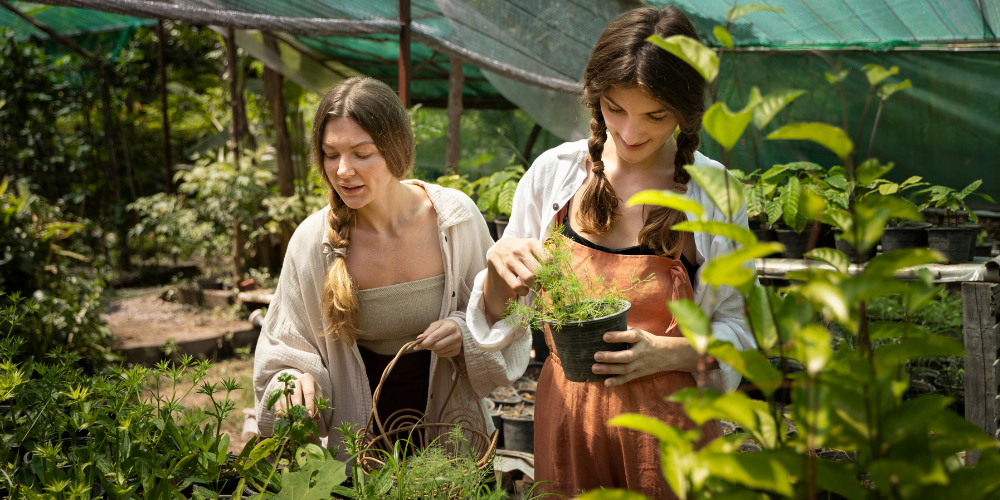
Why Millennials Are Choosing Homesteading Over City Life

The sight of thirty-somethings hauling water buckets or showing off backyard bees has become common. What looks like nostalgia is something else entirely. For a generation that grew up glued to screens and now pays rent like it’s a luxury tax, homesteading feels like a way to step off the hamster wheel—at least for part of the day.
Rethinking Urban Living
Ask anyone paying two-thirds of their income for a studio apartment: at some point, the math—and the stress—stop adding up. Lockdowns were a breaking point for many, forcing them to imagine what life could look like with more space, fresh air, and autonomy. On even a small plot, the hours feel different. Morning begins with chores, not emails; evenings stretch around sunlight, not deadlines.

Freepik | Homesteaders create income streams by selling goods, such as produce and crafts.
Environmental Priorities
This generation has lived through supply shortages, rising utility bills, and summer temperatures that feel unlivable. Installing solar, diverting rainwater, composting kitchen scraps—these are daily experiments in control. Sustainability becomes less of a lofty ideal and more of a rhythm tied to weather, soil, and harvest.
Seeking Financial Stability
Homesteading is rarely sold as a get-rich path, but many are drawn to the financial buffers it creates. A vegetable patch may save grocery money; surplus honey might pay for tools; farm stays can supplement unpredictable income. It’s piecemeal, but dependable in its variety.
Health and Wellness Motivations
One of the first surprises is how differently food tastes when it’s fresh. But health benefits stretch beyond flavor. Everyday work—shoveling, mending, lifting—conditions the body without a gym pass. For the mind, even repetitive chores can bring peace. There’s something about trimming vines or kneading dough that forces a slowing down few apps ever manage.
Balancing Technology Overload
Phones and apps don’t vanish, but their grip loosens. Soil tests replace doomscrolling; weather alerts feel more urgent than likes. Many who homestead remark on the novelty of silence—only broken by the cluck of hens or the sound of wind through trees.
Building Community and Skills
Despite its image, homesteading is rarely solitary. Workshops, seed exchanges, and farmers’ markets turn into classrooms and social hubs. Each skill learned opens another door—cheesemaking, woodworking, herbal remedies—and with every trade, confidence grows.

Freepik | jcomp | Through online platforms, homesteaders can sell products and find a community that values sustainability.
Moving Away From Consumerism
Living this way rewires buying habits. Instead of treating broken items as disposable, repair becomes instinct. Shopping slows down. The result isn’t scarcity, but a shift toward usefulness and durability.
Opportunities for Entrepreneurship
Many discover unplanned income streams: soap-making, workshops, digital tutorials, or farmers’ market stalls. The combination of hands-on work with online storytelling creates unusual opportunities that bridge old and new economies.
Access to Knowledge and Resources
Today’s homesteaders can draw on global information networks their grandparents never had. A YouTube series on soil microbiomes, a seed swap with someone in another country, or online communities trading recipes create a blend of inherited tradition and modern connection.
A Lifestyle That Resonates
Millennials gravitate to homesteading because it aligns with their challenges and ambitions—financial stability, environmental care, personal wellness, and sanity in a hyperconnected age. What looks simple on the surface is actually a layered response to complex pressures.
More in Life Style
-
`
Why Romantic Relationships Thrive On ‘Shared Realities’
Romantic relationships thrive on ‘shared realities.’ A new study published in the Journal of Personality and Social Psychology uncovers how mutual...
February 11, 2025 -
`
How a Three-Day Fasting Can Help You ‘Reverse Aging’
Imagine a world where you could turn back the clock on aging without breaking the bank. The concept of “reverse aging”...
February 4, 2025 -
`
Here’s Why Most Men Do Not Prefer to Be Called ‘Boyfriends’
At its core, the term “boyfriend” carries weight. It is a designation that signals commitment, exclusivity, and a certain level of...
January 28, 2025 -
`
5 Reasons Why You Should Drink Elderberry Juice Every Day
Elderberry juice is not just another trendy health drink. This deep-purple elixir has been used for centuries as a natural remedy...
January 21, 2025 -
`
An Exclusive List of the 2025 Globe Awards Winners
The 2025 Golden Globes delivered an unforgettable night, celebrating the finest achievements in film and television over the past year. From...
January 13, 2025 -
`
What & What NOT to Pack for a Joyous Trip to Rome
Planning a trip to Rome is exciting! But when it comes to packing, it is easy to overthink or overlook essentials....
January 8, 2025 -
`
Is Your Partner Showing Red Flags? Here’s What to Watch For
Healthy relationships are the cornerstone of a fulfilling life, providing emotional support, mutual respect, and trust. However, not every connection we...
January 3, 2025 -
`
Simple and Effective Decluttering Tips to Tidy Up Your Home
Decluttering isn’t just about organizing your space; it’s about creating a stress-free environment that allows you to breathe a little easier...
December 25, 2024 -
`
Ranking the Top 5 Richest Female Rappers of 2024
Who is the richest female rapper now? Well, in 2024, the world of hip-hop is booming, and women are taking the...
December 17, 2024








